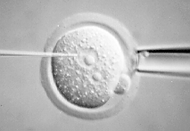Re: can DNA be inserted into other
cells????
Area: Genetics
Posted By: Michael Onken, WashU
Date: Thu May 22 17:03:23 1997
Area of science: Genetics
ID: 862418469.Ge
Message:
Yes!
The insertion of DNA (deoxyribonucleic acids) into
living cells is the hallmark of molecular biology and genetic
engineering. There are several techniques for getting DNA into cells,
depending on the types of cells, whether the cells are from bacteria or
higher eukaryotes (i.e. plants, animals, or fungi), and the types of DNA.
For bacteria:
Two techniques can be used to get DNA into bacteria, infection and
transformation. Infection involves linking the sample DNA to the
DNA of a virus called a bacteriophage, phage for short. The normal activity of a phage is to
attach itself to a bacterium, and inject its DNA into the cell. Any DNA
spliced onto the phage chromosome is carried into the cell with the phage
DNA. Transformation involves linking the sample DNA to a circular
piece of DNA called a plasmid,
and then allowing the bacteria to absorb the DNA through a process
originally described by Fred Griffith in 1928. In the lab, we increase
the rate of transformation by pretreating the bacteria to make them
"competent".
For higher eukaryotes:
The two bacterial techniques, can also be applied to other cells. Viruses
(like Adenovirus in humans or TMV in tobacco plants) can be used to carry
DNA into some cells, but each there are more types of cells than
engineered viruses, so most labs use a process similar to bacterial
transformation to get DNA into their cells. There are specially designed
plasmids for transforming yeast cells and plant cells. In animal cells, transformation has a different
meaning (related to cancer), so we use the term transfection for
the insertion of plasmid DNA into these cells. Specialized plasmids for
transfection of animal
have been engineered to the DNA, and several ways of
getting the plasmids into the cells have been devised. The simplest is
Calcium Phosphate Precipitation, in which the DNA is precipitated
onto salt granules which are "eaten" by the cells. This has a relatively
low transfection efficiency, so many labs use special fat droplets
to carry the DNA into the cells. Some cells are resistant to these
methods, so Electroporation was developed to use a strong electric
current to force the negatively charged DNA into the cells. Some cells,
like plant cells, have tough cell walls that prevent DNA of any kind from
getting into the cells. For these cells, the DNA is coated on microscopic
beads and shot at the cells from a miniature shotgun. Obviously, this
technique can hurt the cells, so it is reserved for special cases.
 The final technique is microinjection. Microinjection is usually reserved for making Transgenic
Mice, mice with new genes added to their cells. To make mice
transgenic, special Embryonic Stem cells are
grown in culture, and then individual cells are injected with DNA through
microscopic glass needles. Then the cells are mixed with normal
embryonic cells and injected into the womb of a female mouse to develop
into a mouse containing the new DNA. This is a very difficult and time
consuming technique, which usually requires taking a course and reading a
manual, or
sending the DNA to another laboratory
which will insert the DNA and grow the mice for you.
The final technique is microinjection. Microinjection is usually reserved for making Transgenic
Mice, mice with new genes added to their cells. To make mice
transgenic, special Embryonic Stem cells are
grown in culture, and then individual cells are injected with DNA through
microscopic glass needles. Then the cells are mixed with normal
embryonic cells and injected into the womb of a female mouse to develop
into a mouse containing the new DNA. This is a very difficult and time
consuming technique, which usually requires taking a course and reading a
manual, or
sending the DNA to another laboratory
which will insert the DNA and grow the mice for you.
Molecular Biologists use almost all of these techniques to study how
genes work, where genes are on the chromosomes, and how different genes
interact.
Current Queue |
Current Queue for Genetics
|
Genetics
archives
Return to The MAD
Scientist Network
MadSci Home | Information |
Search |
Random Knowledge Generator |
MadSci Archives |
Mad Library | MAD Labs |
MAD FAQs |
Ask a ? |
Join Us! |
Help Support MadSci
MadSci Network
© 1997, Washington University Medical School
webadmin@www.madsci.org
 The final technique is microinjection. Microinjection is usually reserved for making Transgenic
Mice, mice with new genes added to their cells. To make mice
transgenic, special Embryonic Stem cells are
grown in culture, and then individual cells are injected with DNA through
microscopic glass needles. Then the cells are mixed with normal
embryonic cells and injected into the womb of a female mouse to develop
into a mouse containing the new DNA. This is a very difficult and time
consuming technique, which usually requires taking a course and reading a
manual, or
sending the DNA to another laboratory
which will insert the DNA and grow the mice for you.
The final technique is microinjection. Microinjection is usually reserved for making Transgenic
Mice, mice with new genes added to their cells. To make mice
transgenic, special Embryonic Stem cells are
grown in culture, and then individual cells are injected with DNA through
microscopic glass needles. Then the cells are mixed with normal
embryonic cells and injected into the womb of a female mouse to develop
into a mouse containing the new DNA. This is a very difficult and time
consuming technique, which usually requires taking a course and reading a
manual, or
sending the DNA to another laboratory
which will insert the DNA and grow the mice for you.